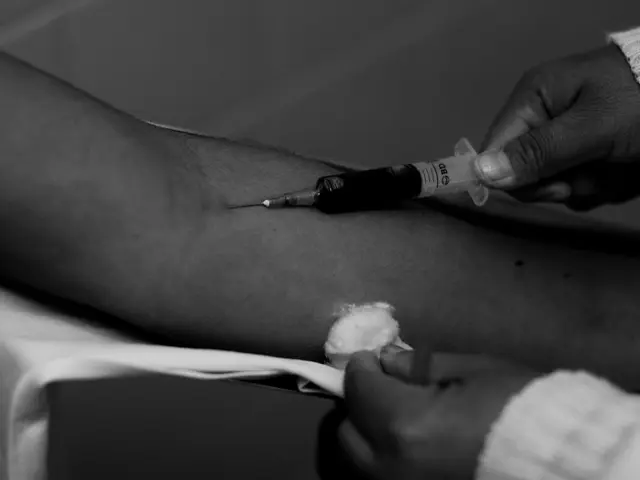Potential Surge of Measles Cases in the U.S. Over the Next Quarter-Century If Vaccination Rates Decrease
Hear this straight up — a slide in MMR vaccination rates across the states over the next 25 years could labor some bugger issues:
- Measles Makes a Comeback: In a worst-case scenario, a 50% dip in childhood vaccinations might yield a whopping 51.2 million measles cases within a quarter-century. That'd be followed by 9.9 million rubella cases, 4.3 million poliomyelitis cases, and just 197 diphtheria cases.You'd be looking at roughly 10.3 million hospital admissions, and an unlucky 159,200 deaths, according to a statistical model from Stanford University.
- More Complications and Casualties: Measles, being super-contagious, can also mean severe issues like pneumonia, encephalitis, and fatalities. Slippin' on the vaccines brings the risk of these complications closer for those who don't build immunity.
- Community Immunity Crumbles: High immune immunity across a population is vital to keep diseases from spreading. Fallin' vaccination rates rattle that immunity and make communities more susceptible to outbreaks.
- Economic Strain: Outbreaks can bring a hefty bill due to healthcare expenses, lost productivity, and public health measures to put an end to outbreaks.
Current Condition of MMR Vaccination Coverage
The current immunization rates fluctuate by place, but overall, there are worries about a gradual decline in some spots:
- National Patterns: Data suggests that MMR vaccination coverage has dipped a tad in some areas, but precise regional figures for 2025 aren't available in published reports.[3][4]
- Geographic Disparity: Areas like New Mexico, Oklahoma, and Texas have noticed significant measles flare-ups, frequently tied to poor vaccination coverage in close-knit communities.[5]
- Global Picture: In the Americas Region, MMR vaccination coverage sank from 95.2% in 2019-2020 to 92.7% in 2023-2024 — stats that might make you wonder about wider trends.[2]
To dodge these pitfalls, public efforts prioritize boostin' vaccination rates, particularly in communities with lower coverage, and enhancin' community education about the advantages of immunization.[4][5]
Impact of Low Vaccination Rates:
- Endemic Diseases: Endemic diseases are continually present within a population, leading to consistent transmission and potential for severe outbreaks.
- ** Loss of Immunity**: High population immunity is essential for preventing widespread disease transmission. Decreased vaccination rates erode this immunity.
- ** Economic Impact**: Outbreaks can result in monetary burdens due to healthcare costs, lost productivity, and public health measures to curb spread.
Current MMR Vaccination Coverage (brief):
- National Coverage Trends: Recent data hints at a slight decrease in MMR vaccination rates in some regions, but specific national data for 2025 is not provided in available reports.
- Regional Distinctions: Regions like New Mexico, Oklahoma, and Texas have grappled with significant measles outbreaks often linked to low vaccination rates in tight-knit communities.
- Global Context: In the Region of the Americas, MMR vaccination coverage declined from 95.2% in 2019-2020 to 92.7% in 2023-2024.
- Science and health experts are raising concerns about the potential consequences of decreasing MMR vaccination rates, predicting a resurgence of endemic diseases like measles, rubella, poliomyelitis, and diphtheria.
- As community immunity weakens due to lower vaccination rates, technology could play a pivotal role in tracking disease outbreaks and improving public health response systems.
- The future of health-and-wellness initiatives may rely on strategically addressing mental-health issues in communities with low vaccination rates, as fear and suspicion towards vaccines could be rooted in unaddressed mental health concerns.
- Politics and general-news platforms have a significant role in shaping public opinion about vaccines, and misinformation can have far-reaching consequences, affecting vaccination rates and potentially contributing to health crises down the line.
- War-and-conflicts and crime-and-justice issues may also impact vaccination rates, as displaced populations and disrupted healthcare systems can lead to reduced access to immunizations.
- To combat the perils posed by slipping MMR vaccination rates, science and technology can be harnessed to develop more efficient and accessible immunization strategies, while community education and policy changes serve to boost vaccination rates, particularly in areas with lower coverage.








